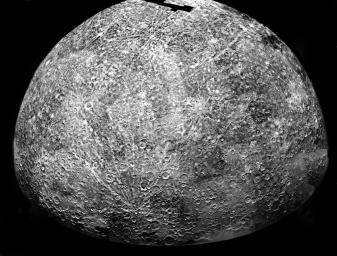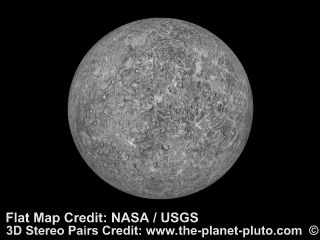|

QueSPER Research Projects
Planets in the Solar System
Mercury
Mercury Mercury Mercury
QueSPER Research Plan and
Note-taking Worksheets

|
|
Mercury
|
Mercury
Printout
Planet Worksheet
 |
How far is
Mercury from the Sun?
 |
Mercury is
the closest planet to the Sun. |
 | Mercury
is, on average, 35.9 million miles from the Sun. |
 | Its orbit
is not a circle. It is an ellipse. |
 | Mercury is
0.38 AU* from the Sun. |
|
 |
How big is Mercury? (What is its
diameter?)
 |
Mercury is
only about 1/3 the size of Earth. |
 |
Mercury is
the smallest planet in our solar system of eight planets. It is the eighth largest planet. |
 |
Mercury is
about the size of our moon. |
 |
Mercury's
diameter is 4879 kilometers or 3,032 miles across
See a diameter |
|
 |
What does
Mercury look like?
 |
Mercury has
craters, smooth areas (plains), hilly areas and long cliffs (scarps).
|
 |
Mercury is
very hot during the day (800°F) and very cold at night. (-280°F). |
 |
It is made
of rock with a dense iron-nickel core. |
 |
It has very
little atmosphere. |
 |
Mercury has
no moons. |
 |
Mercury is a
very old planet. |
|
 |
Why is this
planet named Mercury?
 |
When
astronomers of long ago were studying the night sky, it seemed to them
that Mercury moved very quickly. The planet seemed to move quickly
because it is the closest planet to the sun and its orbit around the sun is
smaller than that of any other planet. |
 |
The planet
has been known since at least the time of the Sumerians over 5000 years
ago. |
 |
The planet
is named
after Mercury, the Roman messenger of the gods, because he too
traveled very quickly. |
|
 |
Can we see
Mercury in the sky at night?
 |
It can be
seen from Earth but it is too close to the sun for us to see it very
often. It is seen at dawn and twilight. |
 | To see if
Mercury is visible to us at this time of year, check the
Sky
Maps. |
*One AU is the distance from the center of the Earth to the
center of the Sun.
Generic QueSPER Research Worksheet |
Links to Other
Sites
Books and References
 |
| Time for Kids Almanac 2003 with
Information Please. NY: Time for Kids Books, 2002. |
RL 4.5 |
Dewey 031.02 |
|
 |
| Farndon, John. The Giant Book
of Space. Brookfield,CT: Copper Beech Bks, 2000. |
RL 4.5 |
Dewey 523.4 |
|
 |
"The Solar System 12/2006: 8
Planets; The New Cosmic Order". National Geographic Magazine. Map
Insert. Dec., 2006. |
RL 8.0 |
|
Other Links to Sites
Nine Planets: Mercury
(The Solar System was reduced to Eight Planets in August, 2006.)

Grade One Research Page
|
![]()
 Mercury
Mercury![]()

 /
/